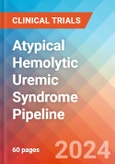Atypical Hemolytic Uremic Syndrome (aHUS) Understanding
Atypical Hemolytic Uremic Syndrome (aHUS): Overview
Atypical hemolytic uremic syndrome (aHUS) is a thrombotic microangiopathy (TMA) that affects multiple organs and the kidneys in particular. aHUS can be sporadic or familial and is most commonly caused by dysregulation of the alternative complement pathway. The initial attack of aHUS can occur at any age, and is associated with a high rate of progression to end stage renal disease. The majority of aHUS is caused by complement system defects impairing ordinary regulatory mechanisms. Activating events therefore lead to unbridled, ongoing complement activity producing widespread endothelial injury. Pathologic mutations include those resulting in loss-of-function in a complement regulatory gene (CFH, CFI, CD46 or THBD) or gain-of-function in an effector gene (CFB or C3). Treatment with the late complement inhibitor, eculizumab - a monoclonal antibody directed against C5 - is effective.'Atypical Hemolytic Uremic Syndrome (aHUS) - Pipeline Insight, 2025' report outlays comprehensive insights of present scenario and growth prospects across the indication. A detailed picture of the Atypical Hemolytic Uremic Syndrome (aHUS) pipeline landscape is provided which includes the disease overview and Atypical Hemolytic Uremic Syndrome (aHUS) treatment guidelines. The assessment part of the report embraces, in depth Atypical Hemolytic Uremic Syndrome (aHUS) commercial assessment and clinical assessment of the pipeline products under development. In the report, detailed description of the drug is given which includes mechanism of action of the drug, clinical studies, NDA approvals (if any), and product development activities comprising the technology, collaborations, licensing, mergers and acquisition, funding, designations and other product related details.
Report Highlights
The companies and academics are working to assess challenges and seek opportunities that could influence in Atypical Hemolytic Uremic Syndrome (aHUS) R&D. The therapies under development are focused on novel approaches to treat/improve in Atypical Hemolytic Uremic Syndrome (aHUS).This segment of the Atypical Hemolytic Uremic Syndrome (aHUS) report encloses its detailed analysis of various drugs in different stages of clinical development, including phase II, I, preclinical and Discovery. It also helps to understand clinical trial details, expressive pharmacological action, agreements and collaborations, and the latest news and press releases.
Atypical Hemolytic Uremic Syndrome (aHUS) Emerging Drugs
Iptacopan: Novartis Pharmaceuticals
Iptacopan is an investigational first-in-class, orally administered targeted factor B inhibitor of the alternative complement pathway. It acts upstream of the C5 terminal pathway, preventing not only intravascular but also extravascular hemolysis in PNH. In doing so, iptacopan may have a therapeutic advantage over anti-C5 therapies by targeting a key part of the biology responsible for PNH while offering an oral monotherapy option. Discovered at the Novartis Institutes for BioMedical Research, iptacopan is currently in development for a number of other complement-mediated diseases (CMDs) where significant unmet needs exist, including kidney diseases C3G, IgAN, atypical hemolytic uremic syndrome (aHUS), membranous nephropathy (MN), lupus nephritis (LN), and blood disorders immune thrombocytopenic purpura (ITP) and cold agglutinin disease (CAD).Atypical Hemolytic Uremic Syndrome (aHUS): Therapeutic Assessment
This segment of the report provides insights about the different Atypical Hemolytic Uremic Syndrome (aHUS) drugs segregated based on following parameters that define the scope of the report, such as:Major Players in Atypical Hemolytic Uremic Syndrome (aHUS)
There are approx. 5+ key companies which are developing the therapies for Atypical Hemolytic Uremic Syndrome (aHUS). The companies which have their Atypical Hemolytic Uremic Syndrome (aHUS) drug candidates in the most advanced stage, i.e. Phase III include, Novartis Pharmaceuticals.Phases
The report covers around 5+ products under different phases of clinical development like
- Late stage products (Phase III)
- Mid-stage products (Phase II)
- Early-stage product (Phase I) along with the details of
- Pre-clinical and Discovery stage candidates
- Discontinued & Inactive candidates
Route of Administration
Atypical Hemolytic Uremic Syndrome (aHUS) pipeline report provides the therapeutic assessment of the pipeline drugs by the Route of Administration. Products have been categorized under various ROAs such as- Oral
- Parenteral
- Intravenous
- Subcutaneous
- Topical
Molecule Type
Products have been categorized under various Molecule types such as
- Monoclonal Antibody
- Peptides
- Polymer
- Small molecule
- Gene therapy
Product Type
Drugs have been categorized under various product types like Mono, Combination and Mono/Combination.Atypical Hemolytic Uremic Syndrome (aHUS): Pipeline Development Activities
The report provides insights into different therapeutic candidates in phase II, I, preclinical and discovery stage. It also analyses Atypical Hemolytic Uremic Syndrome (aHUS) therapeutic drugs key players involved in developing key drugs.Pipeline Development Activities
The report covers the detailed information of collaborations, acquisition and merger, licensing along with a thorough therapeutic assessment of emerging Atypical Hemolytic Uremic Syndrome (aHUS) drugs.Atypical Hemolytic Uremic Syndrome (aHUS) Report Insights
- Atypical Hemolytic Uremic Syndrome (aHUS) Pipeline Analysis
- Therapeutic Assessment
- Unmet Needs
- Impact of Drugs
Atypical Hemolytic Uremic Syndrome (aHUS) Report Assessment
- Pipeline Product Profiles
- Therapeutic Assessment
- Pipeline Assessment
- Inactive drugs assessment
- Unmet Needs
Key Questions
Current Treatment Scenario and Emerging Therapies:
- How many companies are developing Atypical Hemolytic Uremic Syndrome (aHUS) drugs?
- How many Atypical Hemolytic Uremic Syndrome (aHUS) drugs are developed by each company?
- How many emerging drugs are in mid-stage, and late-stage of development for the treatment of Atypical Hemolytic Uremic Syndrome (aHUS)?
- What are the key collaborations (Industry-Industry, Industry-Academia), Mergers and acquisitions, licensing activities related to the Atypical Hemolytic Uremic Syndrome (aHUS)?
- What are the recent trends, drug types and novel technologies developed to overcome the limitation of existing therapies?
- What are the clinical studies going on for Atypical Hemolytic Uremic Syndrome (aHUS) and their status?
- What are the key designations that have been granted to the emerging drugs?
Key Players
- Novartis Pharmaceuticals
- Chugai Pharmaceutical
- Tasly Biopharmaceuticals
- Prestige BioPharma
Key Products
- Iptacopan
- Crovalimab
- B 2067 2
- Eculizumab
This product will be delivered within 2 business days.
Table of Contents
Companies Mentioned (Partial List)
A selection of companies mentioned in this report includes, but is not limited to:
- Novartis Pharmaceuticals
- Chugai Pharmaceutical
- Tasly Biopharmaceuticals
- Prestige BioPharma








